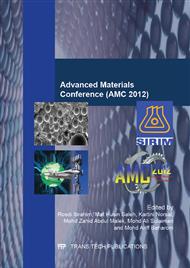p.27
p.32
p.38
p.43
p.51
p.58
p.63
p.73
p.79
Effect of Surface Roughness on Mechanical Properties of Aluminium-Carbon Laminates Composites
Abstract:
Fiber Metal laminates, FML, is a combination of metal with fiber/resin laminates and it is a well-known application in composite laminates due to its dimension stability and properties consistency. Generally, the strength of these laminates systems is much depends on the mechanical interlocking mechanism between the metal surface and the composite laminates. Therefore, surface treatment is needed to enhance the laminates strength. In this research, aluminum plates with different surface roughness were laminated with carbon-fiber/epoxy laminates. The strength of these hybrid systems was then characterized to study the effect of surface roughness on the interfacial strength. It shows that the higher surface roughness will result in better interfacial interaction between the metal surface and the fiber laminates.
Info:
Periodical:
Pages:
51-57
Citation:
Online since:
January 2014
Price:
Сopyright:
© 2014 Trans Tech Publications Ltd. All Rights Reserved
Share:
Citation:


